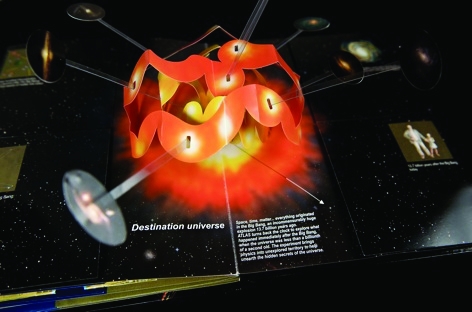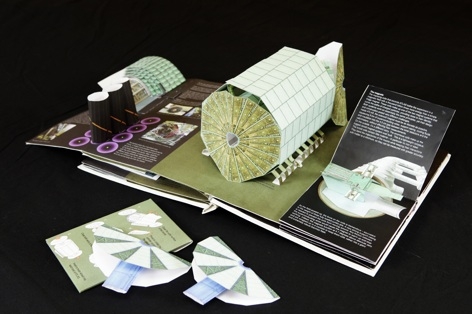Every journalist has a stack of stuff they’ve been given at press conferences. Some are handy, like the bike helmet BASF gave me some years ago. Some are bizarre, like the Australian $10 bill encased in an inch-thick slab of perspex I have sitting on my desk, in case of emergencies (you never know when you’re going to need A$10). But this year’s champion oddity is the review copy of the Large Hadron Collider pop-up book.
It’s the sort of thing that makes people do a double take. ‘The Large Hadron Collider what?’ is the most common response. Written by Emma Sanders and with paper engineering by Anton Radevsky, a master of the art whose previous work has included startling pop-ups of classical and modern architecture, it’s a chunky volume whose four double-page spreads take you from the overall plan of the LHC, down into the caverns, into the massive ATLAS detector, and ends up with a pop-up Big Bang.
No, really, a pop-up Big Bang. I defy you not to be impressed.

And once the quizzical expressions have died down, it’s actually rather impressive. Radevsky’s pop-up designs are truly brilliant, and you actually have to build the ATLAS detector yourself (using extra pop-up bits supplied in an envelope). You really do find yourself caught up with it, and it’s the perfect thing to engage curious older kids (age groups of about eight to young teens, I reckon).

There’s a subset of these complicated pop-ups around at the moment, and I have to confess to being a bit of a fan. You should see the pop-up squid in 20,000 Leagues Under the Sea. And although the LHC Pop-Up is undoubtedly a novelty, it’s one which has a lot to recommend it.
Stuart Nathan
Special Projects Editor
Voyage to the Heart of Matter
By Emma Sanders and Anton Radevsky
Papadakis, £20










Water Sector Talent Exodus Could Cripple The Sector
Maybe if things are essential for the running of a country and we want to pay a fair price we should be running these utilities on a not for profit...